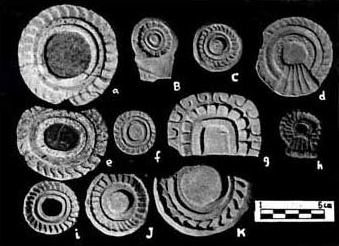
| FAMSI © 2002: Saburo Sugiyama |
||
Censer Symbolism and the State Polity in Teotihuacán
Research Year: 1998 Table of Contents
Introduction The research project focused on the so-called theater-type censers that have been found mainly in Teotihuacán, and the highlands and Pacific slopes of Guatemala. It was intended to provide new perspectives, particularly on state involvement in ceramic production. Specific meanings and functions of images associated with the censer complexes were also examined within broad social contexts; this may lead to a better understanding of Classic period Teotihuacán presence abroad. A ceramic workshop for censer production was found by the National Institute of Anthropology and History (INAH) in 1982, providing an ideal opportunity to interpret imagery in socio-political contexts (Rodríguez, 1982; Múnera, 1985; Langley, 1992). More than 20,000 pieces of molds and ornaments called "adornos," with tools and production debris, were excavated within the largest precinct of the city, called the "Ciudadela" complex (Múnera, 1985). The workshop was located in the western part of the northern enclosure attached on the North Platform of the Ciudadela (Compound 2 of Sector N1E1, according to Millon, Drewitt, and Cowgill, 1973). This long rectangular space was completely closed from the outside with thick, high, masonry walls, but had direct access to the interior of the Ciudadela through two staircases. Therefore, the location can functionally be considered as a part of the Ciudadela complex. Significant amounts of the censers fragments and "adornos" were also found in one of the residential complexes, called "Palaces" in the "Ciudadela." Excavation contexts in the workshop and in the "North Palace" of the "Ciudadela" lead us to the hypothesis that the production and distribution of these objects was most likely controlled by the state. The project was designed to provide further specific, and substantive data, in order to test this proposition through comparative analyses of the censer iconography found in the city and abroad. The project consisted of contextualizing the data from the workshop by publishing it together with a catalog, including library and museum research, a review of public and private collections, and other samples in Teotihuacán and Guatemala. Although the original project was carried out as planned in terms of data collection and analysis, the publication has not been accomplished yet, mainly because a much greater quantity of data was collected than was originally expected, and the complexity of this data required further work in cataloging and analyses. Therefore, the effort supported by the FAMSI grant was dedicated primarily to organizing the data gathered in different places as described below. As a consequence, two volumes of the catalog were prepared to be included in this final report, one titled "Ritual Ceramics at a Workshop in the Ciudadela, Teotihuacán: Catalog" almost ready to be published in México, and another called "Data Base for Theater-type Censers Found in Teotihuacán and Abroad #1," which will be useful in further comparative analyses by any interested researchers. When the included information is published as a book or articles in the future, a copy of them will be sent to the FAMSI Library. Click to download the report in PDF format: Due to the size of the report, it has been broken down into smaller files for faster downloads. The PDF files require Adobe Acrobat Reader.
Submitted 11/23/2001 by: |
||
| Return to top of page | ||
|
Text links to all pages at this site are available at the FAMSI INDEX |
||

